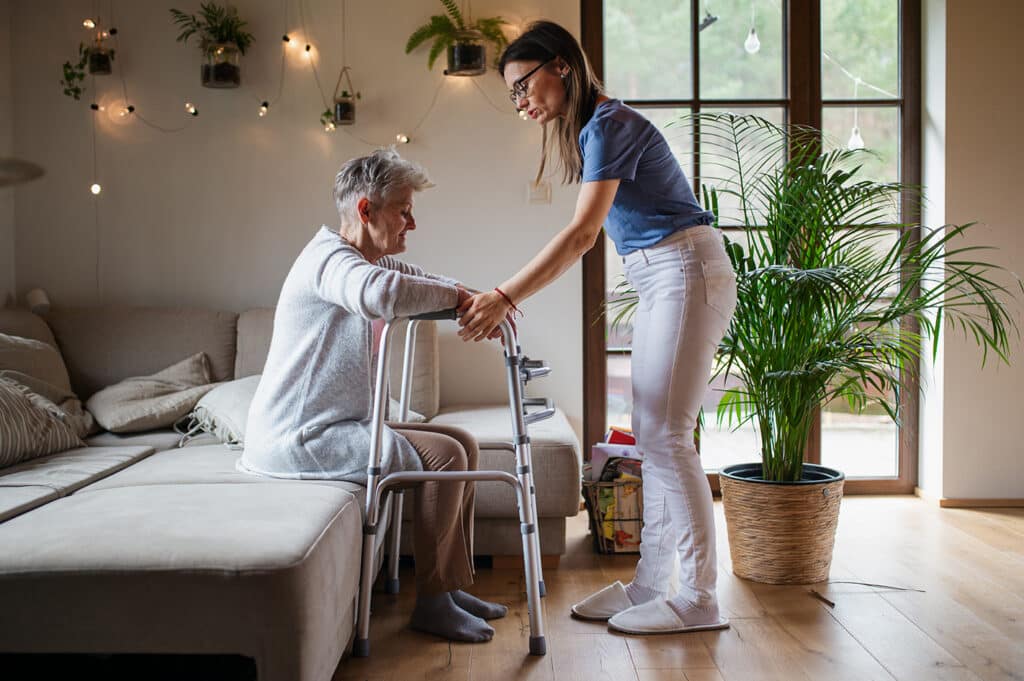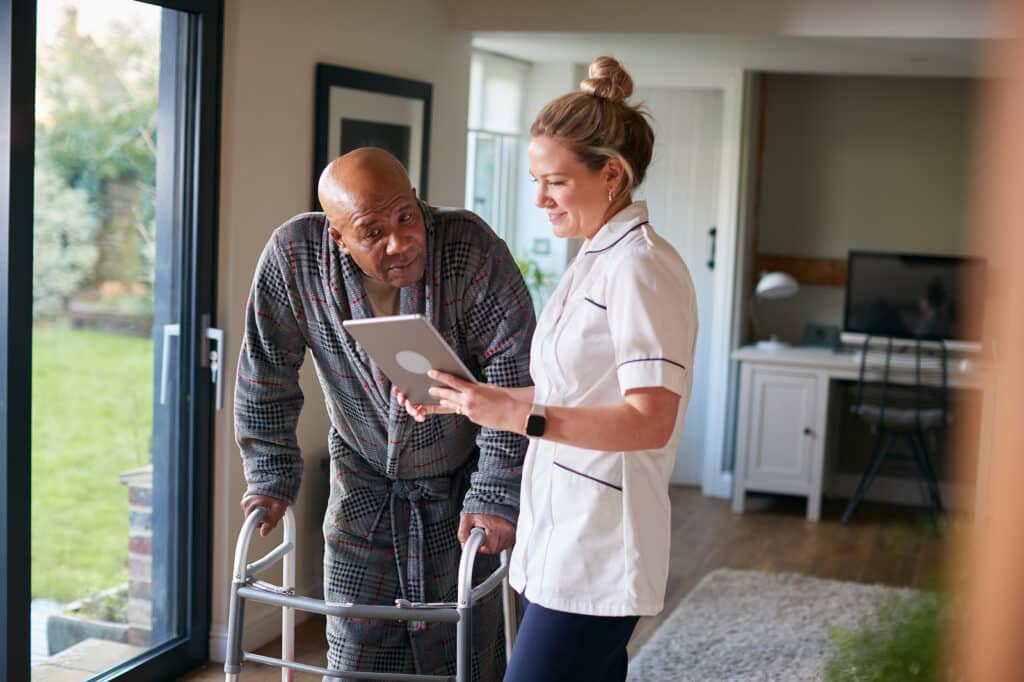Fall Prevention in the Home For Seniors
Purpose Driven Home Care serves to give clients the personal care they need in order for them to continue to live dignified and independent lives in the comfort of their homes. We begin by assessing and understanding our client’s individual needs and meet those needs through selectively assigning qualified, trustworthy, and compassionate Home Care Aides.
Purpose Driven Home Care holds great pride in keeping our client’s health, quality of life, and well-being central in the design and delivery of our services. Having our Home Care Aides in your home can prevent re-hospitalization, postpone institutionalization, and reduce the need for urgent care.
As life expectancies increase, so does the need to make sure our elderly family members and friends are as safe and healthy as possible. Fall prevention in the home is essential for seniors, but many people aren’t aware of how to create a fall-proof environment.
Falls can be especially serious for older adults. In fact, falls are the leading cause of injury-related death among seniors, according to the Centers for Disease Control and Prevention (CDC). This means it’s important to take steps to reduce the risk of falls in our loved ones’ homes.
Creating a safe and secure home environment is not only good for senior citizens, it’s also a meaningful way to show our care and support. It shows we want them to stay independent and enjoy their lives without fear of injury or harm.
What Is Senior Fall Risk Management?
When it comes to fall prevention in the home for seniors, senior fall risk management is an essential part of the equation. It’s more than just setting up a few safety measures; it involves assessing the home environment for potential risks and creating a plan of action to reduce them. A good senior fall risk assessment can help identify any areas that need attention and make sure that your loved one is living in a safe and secure home.
From simple measures like installing grab bars in the bathroom to more elaborate solutions such as adding railings on stairs or improving lighting around walkways, there are numerous ways to reduce the risk of falling. It’s important to consider all aspects of the home environment when taking a senior fall risk assessment, including checking for tripping hazards and ensuring that furniture is placed correctly. It’s also important to make sure that any existing safety equipment is properly maintained and updated if necessary.
What Are The Risk Factors For Falls At Home?
Some common risk factors include:
- slippery surfaces such as wet floors, rugs or tiles;
- cluttered walkways;
- poor lighting;
- furniture that’s difficult to climb over or around.
In addition, medical conditions like:
- low blood pressure,
- vertigo,
- Diabetes.
Seniors should also make sure they’re taking any prescribed medications correctly – side effects from some drugs can affect balance and coordination.
Finally, poor vision or hearing can be additional contributing factors to falls in the home environment.
It’s essential to consider all these potential risks when it comes to fall prevention for seniors at home. Taking steps like removing clutter, installing grab bars and night lights, and wearing properly fitted footwear can help reduce the likelihood of a fall occurring. Understanding the causes of falls is a crucial step towards keeping our loved ones safe from injury.
Providing Senior Fall Risk Management in Bakersfield, Wasco, Shafter, Delano, Lamont, Arvin, Taft, Tehachapi, Frazier Park, McFarland, and surrounding areas.

What Are Fall Prevention Guidelines At Home?
As a family caregiver, it’s essential to be aware of the fall prevention guidelines for seniors at home. Falls can be a major risk in the elderly population, but with the right information and strategies, you can help protect your loved one from such an incident. Luckily, there are plenty of senior fall prevention tips available to help you make sure your elderly family member or patient is safe.
One of the most important steps in preventing falls is to identify potential hazards.
- This means looking around your loved one’s home to ensure that all areas are safe and free from any trip or slip hazards.
- Make sure carpets are secure and not bunched up, check that throw rugs have nonslip backings, and move any furniture that could be blocking pathways.
These simple changes can go a long way towards reducing fall risks.
Additionally, it’s important to discuss medication use with your senior loved one’s doctor or pharmacist.
- Certain medications may increase their risk of falling due to side effects like dizziness or drowsiness.
- You should also ask about vitamin D supplements since low levels can lead to increased risk of bones weakening and fractures occurring after a fall.
Knowing how certain medications affect balance and coordination can help you provide better care while keeping them safe at home.
Our Caregivers are dedicated to providing the best care, read our testimonials and see what others are saying.

How Can Non-Medical Home Care Help Prevent Falls?
Non-medical home care can play an important role in senior fall prevention programs, providing a range of support services that can help prevent falls from occurring.
- Home care workers can provide assistance with everyday tasks such as dressing, bathing, and meal preparation.
- They can also help to make sure that the living environment is safe and hazard-free. This includes ensuring that rugs and electrical cords are securely fastened, removing clutter from pathways, and helping keep up with regular maintenance like changing lightbulbs or checking smoke detectors.
- Having someone around to remind seniors of their medications or to provide transportation to medical appointments is another way non-medical home care can contribute to senior fall prevention programs.
With an experienced professional taking on these duties, seniors have one less thing to worry about – allowing them to stay active and engaged while reducing the risk of slips or trips in the home.
We strive to be one of the leading providers of a wide range of quality medical home health and non-medical home care services.
We offer professional, and compassionate care to the communities we serve. Reach out to us today to get started.
Statistics About Senior Falls In The Home
- Falls among seniors are a pressing issue, with approximately one out of three older adults experiencing a fall each year.
- According to the Centers for Disease Control and Prevention, falls are the leading cause of injury-related death among seniors.
It’s also important to note that many senior falls occur while they’re doing everyday activities such as walking inside or outside their homes, climbing stairs, or getting up from a chair. As such, it’s essential that we take steps to create a safe environment for our elderly family members. Here are four ways we can start today:
1) Assess your loved one’s home for safety hazards and make necessary changes like removing loose cords or throw rugs from high-traffic areas.
2) Ask a healthcare provider about any medications that may increase their risk for falls.
3) Encourage regular physical activity appropriate for their age and abilities to improve balance and strength.
4) Have them wear sensible shoes with good traction when walking around the house or yard.
What Is A Fall Risk Assessment?
Fall risk assessment is an important part of fall prevention in the home for seniors. It’s a process that helps identify physical, environmental and risk factors that can contribute to falls among older adults. By understanding these risks, families, caregivers and health professionals can create personalised plans to reduce the chance of a fall occurring.
During a fall risk assessment, health professionals look at many different areas including:
- Physical condition,
- Vision,
- Mobility,
- Medications,
- Environment,
- Layout of the home,
- Lighting levels,
- Flooring materials.
It’s also important to be aware of lifestyle changes which can help seniors stay safe from falls. Regular exercise programs designed specifically for older adults can help improve balance and coordination while eating healthy meals with enough protein can help build strength.
TIP: If you’re looking for ways to prevent falls among senior citizens in your life, start by scheduling a fall risk assessment with their healthcare provider as soon as possible. This will give you a comprehensive overview of what needs to be addressed so you can develop a plan tailored for their individual needs.

